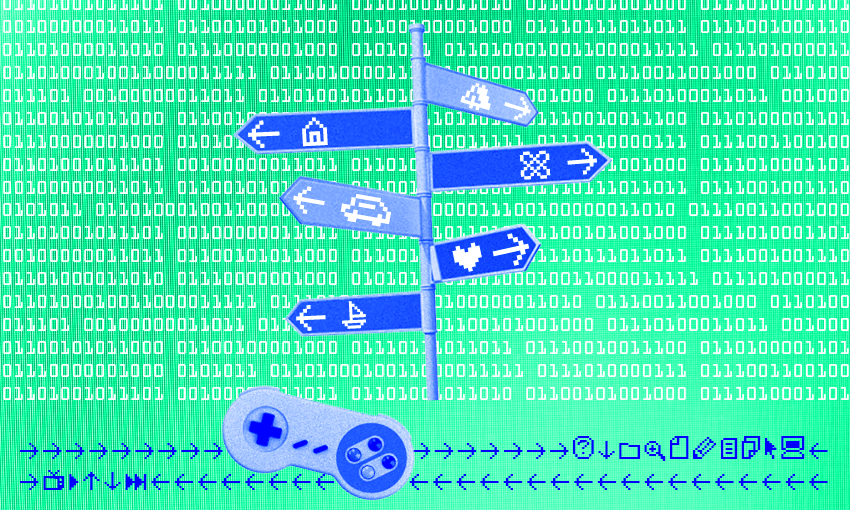Interactive fiction has been around for decades, but the internet is providing novel ways to tell stories where readers shape the outcome. For IRL, Shanti Mathias investigates how creatives in Aotearoa are exploring the format.
You have a choice. You are guiding Māia, a warrior, who has just spotted a ferocious mangā heading for the pā she protects. Do you fight the monster, or do you sprint to the village to warn them about what’s coming?
This is the first of the many, many choices in Metia Interactive‘s game book Guardian Māia. For the most part, the app feels like reading text, scrolling and tapping on your phone for the next piece of the story. But as a reader, you’re constantly prompted to make choices for Māia: where she goes, who she speaks to, and who she saves.
“You’ve giving the player the choice: whatever you do, you know there’s going to be some form of consequence down the track,” says Metia founder Maru Nihoniho. “The interactivity is really exciting.”
Guardian Māia, the first episode of which is available on app stores (a second episode is coming soon), is intended as a prequel to a 3D adventure game the studio is developing. But it’s also an example of the many possibilities of interactive fiction, a form that uses writing, reading, and game-like elements to offer new ways of reading stories.
In Aotearoa, writers and artists are experimenting with interactive literature: are these game/story hybrids also the prequel to literature’s digital future?
This kind of interactive writing has precedent: pick-a-path or choose your own adventure novels have been popular for years, whether they’re stories for children or memoirs by adults. But “there’s less you can do in a paper book format,” says Wellington based novelist M. Darusha Wehm, who writes both linear fiction and interactive stories. Tools like Twine, an editing app widely used to create text-based, web-hosted story games, enable far more complexity than is possible in the pages of a print book.
David Ciccoricco, an associate professor of English at the University of Otago, specialises in studying digital literatures. His field of study is a combination of computer science, literature and psychology, examining how modes of storytelling influence and interact with ways of thinking and the capacity of computers. “Narratives are a vital resource for making sense of our world,” he says.
The fluidity, and distractedness, of online media can’t just be approached by traditional linear novels: this moment requires new narrative forms. “If sci-fi makes the idea of alternative paths more palpable,” he adds, “[then] digitally networked narratives make it palpable on another level.”
The boundaries between mediums like games and written fiction have always been porous. Consider, for example, the literature around roleplaying game Dungeons and Dragons, which has been around since the 70s – hundreds of books of rules and stories that are meant to be interacted with. Wehm believes that the medium of a work of fiction is just “packaging” in service to the needs of the story. “It’s all narrative, it’s all story – whether it’s a book, a play, a comic, a website.”
And story packaging can change. With The Alexander Systems, a short story about virtual reality, they originally wrote a linear story, but it was “never what [they] wanted it to be” until Twine made digital stories easier to code.
Digital writing may just be a different way to tell stories. But to execute it, those who work in these formats must, like any hero embarking on a journey, face some practical challenges.
One is, simply, technical execution. Laya Mutton-Rogers, an illustrator based in Te Whanganui-a-Tara, is the author of Overgrown, a webcomic created for her honours university project in 2018. The story has various animated features, and gives the reader a choice in which order the main character completes tasks. “It’s a lot of work,” Mutton-Rogers says. “My coding skills are basic.” While there are a lot of tools you can use to add interactivity, Mutton-Rogers says that glitches were difficult to fix.
Wehm agrees that the planning and execution of interactive fiction can be much more difficult than writing for print. When they wrote The Martian Job, a 155,000 word interactive novel, they “had to write an outline, go through all the possible endings, figure out how a player gets from Point A to the ending – and make it all make sense.” While outlining is a pretty normal part of writing, the complexity of adding in player choices makes maintaining consistency much more complex.
Maru Nihoniho spoke to Business is Boring about Mehia Interactive’s journey in 2018. Listen on Apple Podcasts, Spotify or your favourite podcast provider.
For writers working in this space, the question of how to make these stories commercially viable is “vexed”, as Ciccoricco puts it. The fluidity of being in-between mediums of gaming and literature makes interactive stories difficult to sell: they are at once a book and a game, and simultaneously neither. “Some gamers don’t like reading, some readers don’t like gaming,” says Nihoniho.
By creating a 3D game and a game book, the company can market to both groups. Without external funding – which Metia has received from the New Zealand Film Commission – it’s a “big struggle” to bring interactive stories and new IP to audiences, Nihoniho says.
Reaching readers and gamers separately is important, because mainstream gaming platforms and book publishers are almost totally “commercially siloed,” Wehm says. Their interactive stories have mainly been published through companies that focus on the form. “You can’t print [interactive webcomics] without changing a lot,” says Mutton-Rogers; this makes the stories much harder to sell and market to publishers and readers.
Given these challenges, what draws creators to this form of storytelling at all? Interactivity is “empowering for the reader, but also the author because it allows you to tell stories that deal with [the] consequences of choices that integrate with the form of the work,” Wehm says. To watch a character die in a TV show is one thing; to read it in a story, and know that you’re responsible, is quite another.
Interactive writing changes the act of reading, too. Instead of passively absorbing a story, watching a TV show just because Netflix automatically loads up the next episode, the reader has to both imagine the story and act within it. In Guardian Māia, the theme of choice isn’t just something that happens to a character; it’s something the reader actively participates in by choosing what actions the character takes.
To a scholar like Ciccoricco, this isn’t interesting just on the level of an individual story: it’s an indication of how the ways we think have been altered by the internet. Online, information is perpetually accessible and interlinked, creating lines of thinking that flip between an app, a message, and an article. Hypertext fiction, an early form of interactive writing where you could click to other parts of the story, is perhaps the clearest example of fiction using the methods of the internet.
The form never really took off beyond some edgy experiments, but according to Ciccoricco, it didn’t have to. You might never have read (or even heard of!) a hypertext novel, but you might still read a recipe on your phone instead of remembering it, and tell your friends about a holiday using the poll function in Instagram Stories, and screenshot an egregious post with your own commentary.
Interactive writing simulates these connected ways of thinking within what Ciccoricco calls “the largest hypertext in existence” in a way that printed books cannot. These forms of writing reflect the kinds of actions and choices – to like or not to like – that everyone experiences online.
How do interactive elements actually shape the content of stories? In Guardian Māia, the story and setting are “interwoven with Māori cultural beliefs,” Nihoniho says, and the interactivity enhances this. The text is paired with tense, tangling music, and images of mythological creatures, and a strange, unsettled landscape – it’s Aotearoa, but not as we know it.
The ability to interact with the story is partially educational: tap an unfamiliar te reo Māori term, and it pulls up a glossary. The interactivity also invites an immersion in te ao Māori: if your character loses mana, you are returned to the realm of Hine-nui-i-te-pō, the goddess of death, and have the opportunity to make different choices.
As a university project put together in six months, Mutton-Rogers’ Overgrown is necessarily much smaller in scope, with fewer choices to make – the reader/player decides the order in which to complete magical tasks to free Bea, the main character, from fairyland. Mutton-Rogers uses the interactive, animated elements to mark a transition from the real world (are those the hills behind Nelson, or perhaps a foresty shortcut through Aro Valley?) into a magical one. At the start of the story, Bea is frustrated and stressed, but in the magical world, she has clear choices to make – and so does the reader.
The potential of interactive fiction is massive, and is having influence beyond specialised publishers and the world of gaming. In 2018, for example, Netflix debuted a special episode of Black Mirror, Bandersnatch, which allowed the viewer to make choices with their remotes. Still, traditional books, games, and movies aren’t going anywhere. “People have been talking about interactive fiction disrupting traditional fiction as long as I’ve been in this space. I just don’t see it happening,” says Wehm.
When you want to immerse yourself in fiction, are you playing a game, reading a book, or doing both at once? More than ever before, you have a choice.



